| Dear Daniel: Further to the last post, here are a few more cites to
other weaving groups using the trefoil design element : Khamseh-Cover of
Woven Gardens by Black and Loveless. See also Hali, Vol. 2, No.3. Arab
Baluch- Atlantic Collections plate 295. Transcaucasian- Hali 105, page 57
(Asad Khan) Qashqai-Krikor Markarian, image not available There are some
minor differences, mostly in coloration, between these pieces. But the
same is true of the Kurdish examples. I have a bag face, barely
discernable in the original image posted of the group of four long rugs,
the two long rugs, as well as a sauj bulagh example posted elsewhere in
which it appears in two directions in different places. They all are
colored a little different. Also some are contained in a lattice, others
as part of an overall field motif. What they all have in common is the
distinctive trefoil drawing which at times can be quite a strong feeling
ornament. I have wondered whether there is a possible connection between
these devices and those found on another group of distinctive so-called
"tuning fork" Kurdish long rugs, an example of which can be seen at Hali
70, page 93, plate 15. Interestingly, this group of rugs often has a
border which contains the "L" shaped bud we discussed in connection with
the jaf bag belonging to Kenneth Thompson. Any thoughts? Thank you,
Michael |
 One
possibility to explain this feature is that this Afshar mafrash could have
been woven in North West Persia. (an Afshar enclave is known south of
Bidjar) or that the Kurdish tribes and the Afshar learned to weave this
design when they were inhabiting Eastern Anatolia (before migrating to
North West Persia Afshar tribes settled south of lake Van). Thanks,
Daniel
One
possibility to explain this feature is that this Afshar mafrash could have
been woven in North West Persia. (an Afshar enclave is known south of
Bidjar) or that the Kurdish tribes and the Afshar learned to weave this
design when they were inhabiting Eastern Anatolia (before migrating to
North West Persia Afshar tribes settled south of lake Van). Thanks,
Daniel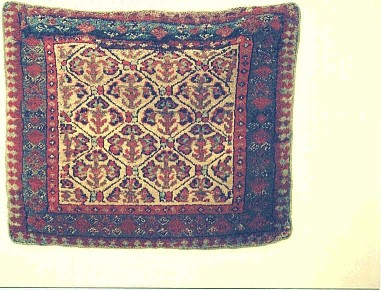
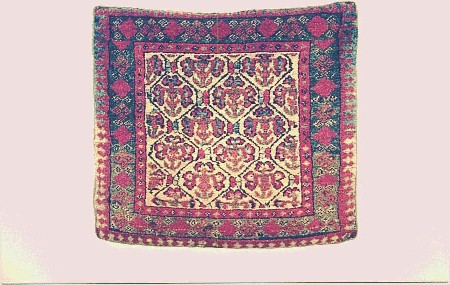 Finally, another example of Kurdish rug with "trefoil" design is
represented by plate 22 in the Dodds book on the Fisher collection.
Regards Guido
Finally, another example of Kurdish rug with "trefoil" design is
represented by plate 22 in the Dodds book on the Fisher collection.
Regards Guido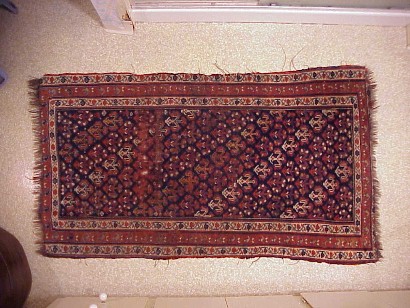 It contains some rather odd
creatures, extinct by now, I suspect. I call them Dr. Seuss animals;
It contains some rather odd
creatures, extinct by now, I suspect. I call them Dr. Seuss animals; 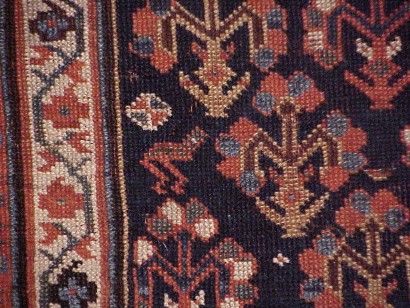
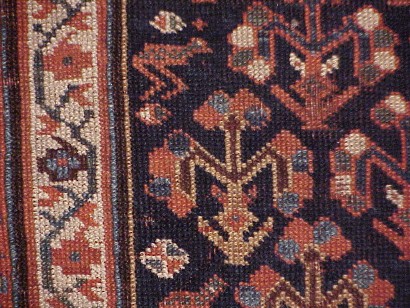 and the back;
and the back; 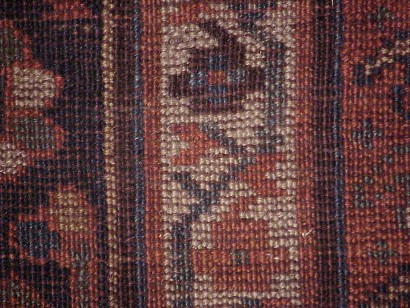 A
variation shows up in the main border of the Qashqai rug I admitted to
buying, shown in a salon about "Your First Time". The MacDonald reference
is the first I recall from the Nafar tribe. Is it credulous? The wool in
the rug above is very fine and the colors have a depth unfamiliar to me.
It very well could be from a tribe with a very small output, "different"
sheep and isolated dyers. Patrick Weiler
A
variation shows up in the main border of the Qashqai rug I admitted to
buying, shown in a salon about "Your First Time". The MacDonald reference
is the first I recall from the Nafar tribe. Is it credulous? The wool in
the rug above is very fine and the colors have a depth unfamiliar to me.
It very well could be from a tribe with a very small output, "different"
sheep and isolated dyers. Patrick Weiler